| Listing 1 - 10 of 43 | << page >> |
Sort by
|
Book
ISBN: 9780415808873 9780203098615 9781136227943 9781136227899 9781136227936 9781138936980 Year: 2013 Volume: 29 Publisher: New York London Routledge
Abstract | Keywords | Export | Availability | Bookmark
 Loading...
Loading...Choose an application
- Reference Manager
- EndNote
- RefWorks (Direct export to RefWorks)
American literature --- Thematology --- Psychological study of literature --- AIDS (Disease) in literature --- AIDS in de literatuur --- Gay men in literature --- Hommes homosexuels dans la littérature --- Homoseksuele mannen in de literatuur --- Loss (Psychology) in literature --- Perte (Psychologie) dans la littérature --- SIDA dans la littérature --- Verlies (Psychologie) in de literatuur --- Gays' writings [American ] --- History and criticism --- Gay men --- Identity
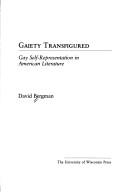
ISBN: 0299130509 Year: 1991 Volume: *1 Publisher: Madison University of Wisconsin Press
Abstract | Keywords | Export | Availability | Bookmark
 Loading...
Loading...Choose an application
- Reference Manager
- EndNote
- RefWorks (Direct export to RefWorks)
American literature --- Thematology --- Gay men in literature --- Hommes homosexuels dans la littérature --- Homoseksuele mannen in de literatuur --- Gays' writings [American ] --- History and criticism --- Male authors --- Homosexuality and literature --- United States --- Ashbery, John Lawrence --- Criticism and interpretation --- Baldwin, James --- Matthiessen, Francis Otto --- Williams, Tennessee --- Whitman, Walt --- Howard, Richard

ISBN: 0822321734 0822396025 0822321610 132214107X Year: 1998 Publisher: Durham (N.C.) : Duke university press,
Abstract | Keywords | Export | Availability | Bookmark
 Loading...
Loading...Choose an application
- Reference Manager
- EndNote
- RefWorks (Direct export to RefWorks)
In A Small Boy and Others, Michael Moon makes a contribution to our understanding of the dynamics of sexuality and identity in modern American culture. He explores a wide array of literary, artistic, and theatrical performances, ranging from the memoirs of Henry James and the dances of Vaslav Nijinsky to the Pop paintings of Andy Warhol and such films as Midnight Cowboy, Blue Velvet, and Jack Smith's Flaming Creatures. Moon illuminates the careers of James, Warhol, and others by examining the imaginative investments of their protogay childhoods in their work in ways that enable new, more complex cultural readings. Moon reveals how the works of these artists emerge from an engagement that is obsessive to the point of "queerness." Rich in historical detail and insistent in its melding of the recent with the remote, the literary with the visual, the popular with the elite, A Small Boy and Others presents a hitherto unimagined tradition of queer invention.
Gay men in literature --- Gays in popular culture --- Hommes homosexuels dans la littérature --- Homoseksualiteit in de film --- Homoseksuele mannen in de literatuur --- Homoseksuelen in volkscultuur --- Homosexuality in motion pictures --- Homosexualité dans le cinéma --- Homosexuels dans la culture populaire --- Culture in motion pictures. --- Gay men in literature. --- Gays in popular culture. --- Homosexuality in motion pictures. --- Motion pictures --- Popular culture --- Gay people in popular culture.
Book
ISBN: 9781107646186 9781107110250 9781107046498 Year: 2015 Volume: *169 Publisher: Cambridge Cambridge University Press
Abstract | Keywords | Export | Availability | Bookmark
 Loading...
Loading...Choose an application
- Reference Manager
- EndNote
- RefWorks (Direct export to RefWorks)
Gay men in literature --- Hommes homosexuels dans la littérature --- Homoseksualiteit en literatuur --- Homoseksuele mannen in de literatuur --- Homosexuality and literature --- Homosexualité et littérature --- Lesbians in literature --- Lesbiennes dans la littérature --- Lesbiennes in de literatuur --- Littérature américaine --- Histoire et critique --- Gays' writings [American ] --- History and criticism --- Homosexualité et littérature. --- Histoire et critique. --- Littérature américaine --- Homosexualité et littérature.
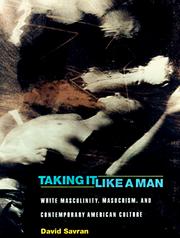
ISBN: 0691058768 0691016372 9786612753367 1400813271 1400822467 1282753363 9781400822461 9781400813278 9780691058764 9780691016375 9781282753365 6612753366 140080700X 1400806984 9781400806980 9781400807000 Year: 1998 Publisher: Princeton, N.J. Princeton University Press
Abstract | Keywords | Export | Availability | Bookmark
 Loading...
Loading...Choose an application
- Reference Manager
- EndNote
- RefWorks (Direct export to RefWorks)
From the Beat poets' incarnation of the "white Negro" through Iron John and the Men's Movement to the paranoid masculinity of Timothy McVeigh, white men in this country have increasingly imagined themselves as victims. In Taking It Like a Man, David Savran explores the social and sexual tensions that have helped to produce this phenomenon. Beginning with the 1940's, when many white, middle-class men moved into a rule-bound, corporate culture, Savran sifts through literary, cinematic, and journalistic examples that construct the white man as victimized, feminized, internally divided, and self-destructive. Savran considers how this widely perceived loss of male power has played itself out on both psychoanalytical and political levels as he draws upon various concepts of masochism--the most counterintuitive of the so-called perversions and the one most insistently associated with femininity. Savran begins with the writings and self-mythologization of Beat writers William Burroughs, Allen Ginsberg, and Jack Kerouac. Although their independent, law-defying lifestyles seemed distinctively and ruggedly masculine, their literary art and personal relations with other men in fact allowed them to take up social and psychic positions associated with women and racial minorities. Arguing that this dissident masculinity has become increasingly central to U.S. culture, Savran analyzes the success of Sam Shepard as both writer and star, as well as the emergence of a new kind of action hero in movies like Rambo and Twister. He contends that with the limited success of the civil rights and women's movements, white masculinity has been reconfigured to reflect the fantasy that the white male has become the victim of the scant progress made by African Americans and women. Taking It Like a Man provocatively applies psychoanalysis to history. The willingness to inflict pain upon the self, for example, serves as a measure of men's attempts to take control of their situations and their ambiguous relationship to women. Discussing S/M and sexual liberation in their historical contexts enables Savran to consider not only the psychological function of masochism but also the broader issues of political and social power as experienced by both men and women.
Hommes dans la culture populaire --- Hommes dans la littérature --- Mannen in de literatuur --- Mannen in de volkscultuur --- Men in literature --- Men in popular culture --- Psychological study of literature --- Sociology of culture --- United States --- Reverse discrimination --- Masochism --- Men in literature. --- Masculinity --- Men, White --- Discrimination --- Psychic masochism --- Paraphilias --- Personality disorders --- Sadomasochism --- Suffering --- Popular culture --- White men --- United States of America
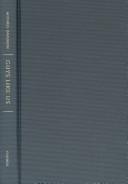
ISBN: 0226137406 Year: 2004 Publisher: Chicago London University of Chicago Press
Abstract | Keywords | Export | Availability | Bookmark
 Loading...
Loading...Choose an application
- Reference Manager
- EndNote
- RefWorks (Direct export to RefWorks)
Cold War in literature --- Gay men in literature --- Guerre froide dans la littérature --- Hommes dans la littérature --- Hommes homosexuels dans la littérature --- Homoseksuele mannen in de literatuur --- Koude oorlog in de literatuur --- Mannelijkheid in de literatuur --- Mannen in de literatuur --- Masculinity in literature --- Masculinité dans la littérature --- Men in literature --- American poetry --- Cold War in literature. --- Gay men in literature. --- Homosexuality and literature --- Male homosexuality, in literature. --- Masculinity in literature. --- Men in literature. --- Political poetry, American --- Politics and literature --- Male authors --- History and criticism. --- History --- 20th century --- History and criticism --- United States --- Political poetry [American ] --- Homosexuality in literature --- Spicer, Jack --- Bishop, Elizabeth --- Criticism and interpretation --- Plath, Sylvia --- Baraka, Imamu Amiri --- Cha, Theresa Hak Kyung --- Lorde, Audre --- O'Hara, Frank --- Rexroth, Kenneth --- Rich, Adrienne
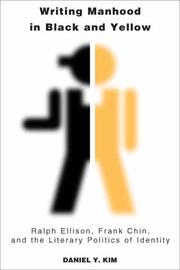
ISBN: 0804751099 0804751080 9780804751087 Year: 2005 Volume: *5 Publisher: Stanford Stanford University Press
Abstract | Keywords | Export | Availability | Bookmark
 Loading...
Loading...Choose an application
- Reference Manager
- EndNote
- RefWorks (Direct export to RefWorks)
African American men in literature --- Afro-Amerikaanse mannen in de literatuur --- Américains aziatiques dans la littérature --- Asian Americans in literature --- Aziatische Amerikanen in de literatuur --- Gay men in literature --- Groepsgevoel in de literatuur --- Group identity in literature --- Hommes afro-americains dans la littérature --- Hommes homosexuels dans la littérature --- Homoseksuele mannen in de literatuur --- Identité de groupe dans la littérature --- Mannelijkheid in de literatuur --- Masculinity in literature --- Masculinité dans la littérature --- Race dans la littérature --- Race in literature --- Ras in de literatuur --- American literature --- Men in literature --- Masculinity (Psychology) in literature --- English literature --- Agrarians (Group of writers) --- Afro-American men in literature --- Minority authors&delete& --- History and criticism --- Chin, Frank, --- Ellison, Ralph --- אליסון, ראלף --- 赵健秀, --- Criticism and interpretation. --- Chin, Frank Chew --- Criticism and interpretation --- Minority authors --- Ellison, Ralph Waldo --- 赵健秀

ISBN: 0826215165 0826262465 9780826262462 9780826215161 Year: 2004 Publisher: Columbia University of Missouri Press
Abstract | Keywords | Export | Availability | Bookmark
 Loading...
Loading...Choose an application
- Reference Manager
- EndNote
- RefWorks (Direct export to RefWorks)
African American men in literature --- Afro-Amerikaanse mannen in de literatuur --- Hommes afro-americains dans la littérature --- Hommes dans la littérature --- Mannelijkheid in de literatuur --- Mannen in de literatuur --- Masculinity in literature --- Masculinité dans la littérature --- Men in literature --- Race dans la littérature --- Race in literature --- Ras in de literatuur --- African Americans --- American fiction --- Modernism (Literature) --- Masculinity (Psychology) in literature --- American literature --- Afro-American men in literature --- Intellectual life --- African American authors&delete& --- History and criticism --- Hurston, Zora Neale --- Toomer, Jean, --- Characters --- Men. --- African American authors --- 20th century --- Men --- United States --- Toomer, Jean --- Morrison, Toni --- Naylor, Gloria --- Wideman, John Edgar --- African American men in literature. --- Masculinity in literature. --- Race in literature. --- Men in literature. --- History and criticism.
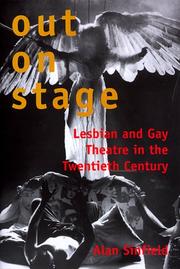
ISBN: 0300081022 Year: 1999 Publisher: New Haven, Conn. London Yale University Press
Abstract | Keywords | Export | Availability | Bookmark
 Loading...
Loading...Choose an application
- Reference Manager
- EndNote
- RefWorks (Direct export to RefWorks)
English literature --- Psychological study of literature --- Drama --- anno 1900-1999 --- Gay men in literature --- Hommes homosexuels dans la littérature --- Homoseksuele mannen in de literatuur --- Lesbians in literature --- Lesbiennes dans la littérature --- Lesbiennes in de literatuur --- English drama --- Gay men in literature. --- Gays --- Gays' writings, American --- Gays' writings, English --- Homosexuality and literature --- Lesbians in literature. --- History and criticism. --- Intellectual life. --- History --- History and criticism --- Intellectual life --- United States --- 20th century --- Great Britain --- Gays' writings [American ] --- Gays' writings [English ] --- Williams, Tennessee --- Criticism and interpretation
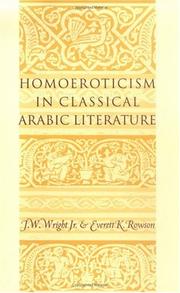
ISBN: 023110507X 0231105061 9780231105071 Year: 1997 Publisher: Columbia: Columbia university press,
Abstract | Keywords | Export | Availability | Bookmark
 Loading...
Loading...Choose an application
- Reference Manager
- EndNote
- RefWorks (Direct export to RefWorks)
This text examines the importance of masculine homosexual allusion in classical Arabic literature. It explores the underlying meanings of masculine motifs in classical texts. The fawn, for example, was often a symbol for the ethereally beautiful male youth, while the stallion represented masculine bravery and valour. For the most part such symbols do not represent homosexual intention, but are a reflection of sublime erotic ideals intertwined with religious beliefs. This text does not so much locate homosexuality in Arabic literature as it explores the use of male motifs, masculine allusion and phallic symbols as expressions of meanings that have often been misinterpreted throughout the centuries. It also connects Arabic literature with political conventions, social mores and theology.
Hommes dans la littérature --- Homoseksualiteit in de literatuur --- Homosexuality in literature --- Homosexualité dans la littérature --- Mannen in de literatuur --- Men in literature --- Seksualiteit in de literatuur --- Sex in literature --- Sexe dans la littérature --- Homoeroticism. --- Erotic literature, Arabic --- Homosexuality in literature. --- Men in literature. --- Sex in literature. --- History and criticism. --- Erotic literature [Arabic ] --- History and criticism --- Littérature érotique arabe --- Homosexualité masculine --- Thèmes, motifs --- Dans la littérature
| Listing 1 - 10 of 43 | << page >> |
Sort by
|

 Search
Search Feedback
Feedback About UniCat
About UniCat  Help
Help News
News